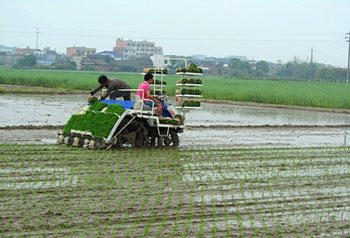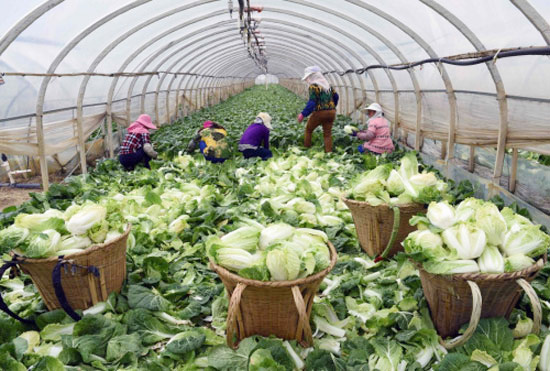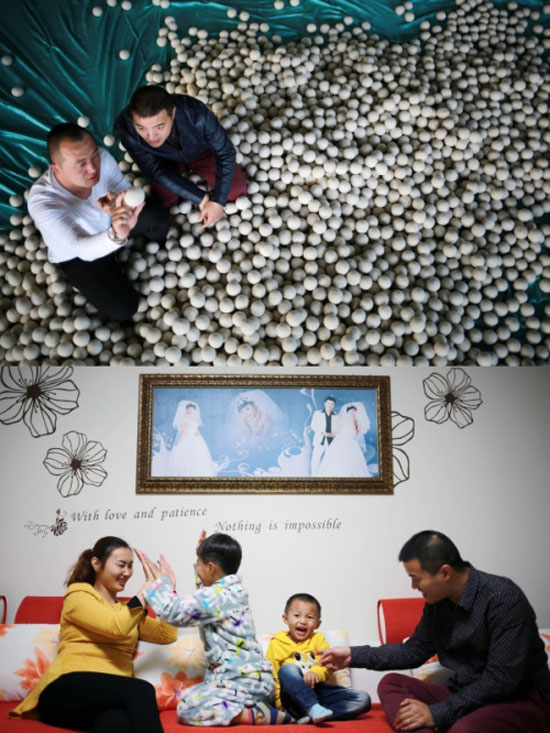Technical Guidance and Protection of Early Rice Breeding and Transplanting in South China
Original Title: Technical Guidance for Early Rice Breeding and Transplanting in South China in 2016

Early rice breeding and transplanting in South China (network map)
At present, the sowing, seedling raising and transplanting of early rice in the south have been carried out from south to north for six times. Affected by the early low temperature and rainy weather, the overall progress of early rice sowing and seedling raising this year is slow, and the seedling quality in some areas is weak. In view of the current climate characteristics and seedling quality, the key links such as cold resistance and heat preservation, fertilizer and water promotion control, disease and insect prevention and control should be emphasized, and strong seedlings should be cultivated and transplanted in time to lay a foundation for maintaining area, stabilizing yield and improving quality of early rice in southern China. The following technical guidance suggestions are put forward.
First, select fine varieties and seed treatment. According to ecological conditions and transplanting methods, early rice varieties with high yield, good quality, strong resistance and good adaptability were selected. Before sowing, sun seed, seed selection, seed soaking, disinfection and germination shall be done to prevent the occurrence of bakanae disease. Factorization, large (medium) shed, film covering and insulation seedling raising are advocated where conditions permit.
2. Sow seeds at the right time according to heaven and earth. When the average temperature of the day stably passes 12℃, avoid rainy weather and select early rice varieties with suitable growth period to sow at the right time. To seize the opportunity of "cold tail warm head", early rice in the middle and lower reaches of the Yangtze River strives to complete sowing before and after Qingming.
Third, temperature control with water, cold and freeze. Recently, the temperature in some areas of the south fluctuates greatly, which is unfavorable for early rice spring sowing and cultivation of strong seedlings. The cold prevention work should be strengthened for the sown seedling fields. Those that are not covered with plastic film should be covered with plastic film in time. At the same time, scientific irrigation methods such as "night irrigation and daily drainage" and "sunny drainage and rain irrigation" should be adopted to adjust the water and heat conditions of the seedling fields to prevent rotten seeds and seedlings.
4. Scientific regulation and control, cultivating strong seedlings. During seedling raising, remove the film at both ends for ventilation at the same time of heat preservation to prevent diseases; in case of continuous sunny day and high temperature (≥35℃ in the film) weather, remove the film for ventilation to prevent high temperature burning seedlings; in case of sudden sunny weather from continuous overcast rain, do not suddenly remove the film, blindly apply quick-acting fertilizer such as urea, etc., ventilate and refine seedlings before removing the film, and sprinkle water or irrigate the seedling bed while removing the film. 1 leaf 1 heart stage suitable temperature moisture seedlings, prevent excessive growth, pay attention to prevent the occurrence of cotton rot, seedling blight;2 leaves 1 heart stage ventilation tempering, fertilizer to promote tillers, cultivate strong seedlings;3 leaves 1 heart stage to carry out day cover, 5-7 days before transplanting with 1%-2% urea solution drenching "marriage fertilizer", after application of water or 3-5 days before transplanting fertilizer, generally 4-5 kg urea per mu seedling field. For weak seedlings, increase phosphorus and potassium fertilizer to maintain water balance and promote recovery growth. In case of "late spring cold", pay attention to the intact insulation facilities, adjust the temperature with water in time, keep the field temperature, and prevent rotten seedlings from dying.
5. Classification guidance and timely transplanting. When the average temperature of that day is stable and passes 15℃, it will be sunny and transplanted, and South China will strive to complete transplanting before and after Qingming. For machine-transplanted fields, the quality of the whole field should be improved. Before transplanting, the fields should be solid, timely and early transplanting should be achieved, shallow transplanting should be made every effort, and the density should be increased appropriately. The seedling age is generally about 20 days, and the transplanter with 25 cm row spacing should be selected to avoid the extension of slow seedling caused by excessive seedling age. More than 20,000 holes should be planted per mu. The planting density should be ensured and the uniformity should be improved; the seedling age is generally 25-30 days, the high-yield field is planted with 20,000 - 25,000 holes per mu, the hybrid rice has 2-3 seedlings per hole, the conventional rice has 5-6 seedlings per hole, and the basic seedlings per mu reach 50,000 - 60,000 and 100,000 - 120,000 respectively. The planting density should be increased for the three-crop field, the seedling age should not exceed 35 days, and the planting density per mu should be more than 25,000 holes. (National Agricultural Technology Extension Service Center of Rice Expert Steering Group of Ministry of Agriculture)
- Prev

Vegetables from Yunnan plateau are popular in Beijing, Guangzhou and Shenzhen.
Vegetables from Yunnan plateau are popular in Beijing, Guangzhou and Shenzhen.
- Next

Employment, entrepreneurship, making money at home, no need to go abroad
Employment, entrepreneurship, making money at home, no need to go abroad
Related
- A course of planting techniques and methods on how to grow carrots
- How to plant the latest tulips?
- Is it better to pick tea in the morning or in the afternoon? When is the best time for tea to be picked? what is the third or fifth tea?
- Launch Yuanxiao Happy combination Haocha + Tea Yuan healthy Taste
- Penghu Tourism "Fireworks 20 Parade with You"
- 2022 West Lake Happiness holds "Digital Revitalization Voucher" and draws iphone13 and laptop.
- Banqiao Fuzhou social houses are designed to change start-up combined with police elimination to create a safe and livable environment
- The convenient measure of "mechanical weeding" in Xinbei has been abused and the Agriculture Bureau has imposed heavy penalties on the illegal land consolidation.
- Changgeng University Joins Hands with Four Memory Factories to Rescue Memory Talent Shortage
- The list of Taiwan's top 100 MVP managers is listed by the Director-General of the Farmers' Association of Sanxia District.

